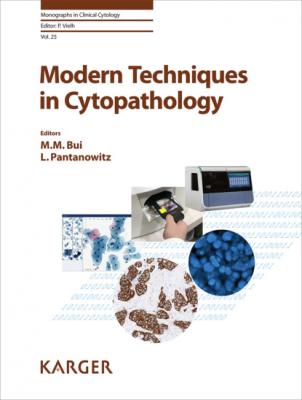ТОП просматриваемых книг сайта:
Modern Techniques in Cytopathology. Группа авторов
Читать онлайн.Название Modern Techniques in Cytopathology
Год выпуска 0
isbn 9783318065763
Автор произведения Группа авторов
Жанр Биология
Серия Monographs in Clinical Cytology
Издательство Ingram
Conclusion
A plethora of old and new methods are available for routinely preparing cell blocks in cytology practice. However, to date no single method has been widely adopted by all cytology laboratories. Several steps can be undertaken to enhance the cellularity of cell blocks, some which occur at the point-of-care, including better operator skill, enhanced specimen adequacy, proper triage, and dedicated passes for cell block [19], and others which can be implemented in cytology and histology laboratories. Despite ongoing development of new and improved cell block techniques, the production and optimal utilization of cell blocks remains a work in progress that requires standardization. This is important because without assured adequate cellularity in cell blocks, the tendency will be to continually move towards competing specimens such as core-needle biopsies or hybrid cytology-histology samples.
References
1Xing W, Hou AY, Fischer A, Owens CL, Jiang Z: The Cellient automated cell block system is useful in the differential diagnosis of atypical glandular cells in Papanicolaou tests. Cancer Cytopathol 2014;122:8–14.
2Calabretto ML, Giol L, Sulfaro S: Diagnostic utility of cell-block from bronchial washing in pulmonary neoplasms. Diagn Cytopathol 1996;15:191–192.
3Collins GR, Thomas J, Joshi N, Zhang S: The diagnostic value of cell block as an adjunct to liquid-based cytology of bronchial washing specimens in the diagnosis and subclassification of pulmonary neoplasms. Cancer Cytopathol 2012;120:134–141.
4Mathew EP, Nair V: Role of cell block in cytopathologic evaluation of image-guided fine needle aspiration cytology. J Cytol 2017;34:133–138.
5Bahrenburg L: On the diagnostic results of the microscopical examination of the ascitic fluid in two cases of carcinoma involving the peritoneum. Cleve Med Gazz 1896;11:274–278.
6Saqi A: The state of cell blocks and ancillary testing: past, present, and future. Arch Pathol Lab Med 2016;140:1318–1322.
7Crapanzano JP, Heymann JJ, Monaco S, Nassar A, Saqi A: The state of cell block variation and satisfaction in the era of molecular diagnostics and personalized medicine. Cytojournal 2014;11:7.
8Varsegi GM, Shidham V: Cell block preparation from cytology specimen with predominance of individually scattered cells. J Vis Exp 2009;29:1316.
9La Fortune KA, Randolph ML, Wu HH, Cramer HM: Improvements in cell block processing: the cell-gel method. Cancer 2017;125:267–276.
10Kulkarni MB, Desai SB, Ajit D, Chinoy RF: Utility of the thromboplastin-plasma cell-block technique for fine-needle aspiration and serous effusions. Diagn Cytopathol 2009;37:86–90.
11Sung S, Sireci A, Remotti H, Hodel V, Mansukhani M, Fernandes H, Saqi A. Plasma Thrombin Cell Blocks: Potential Source of DNA Contamination. Cancer Cytopathology. In press.
12Zanini C, Gerbaudo E, Ercole E, Vendramin A, Forni M: Evaluation of two commercial and three home-made fixatives for the substitution of formalin: a formaldehyde-free laboratory is possible. Environ Health 2012;11:59.
13Cahill L: Best practices in cytopathology for cell blocks survey results. ASC Bulletin, American Society of Cytopathology. Volume LI, Number 2, 2014.
14Yang GC, Wan LS, Papellas J, Waisman J: Compact cell blocks. Use for body fluids, fine needle aspirations and endometrial brush biopsies. Acta Cytol 1998;42:703–706.
15Yung RC, Otell S, Illei P, et al: Improvement of cellularity on cell block preparations using the so-called tissue coagulum clot method during endobronchial ultrasound-guided transbronchial fine-needle aspiration. Cancer Cytopathol 2012;120:185–195.
16Jain D, Mathur SR, Iyer VK: Cell blocks in cytopathology: a review of preparative methods, utility in diagnosis and role in ancillary studies. Cytopathology 2014;25:356–371.
17Choi YI, Jakhongir M, Choi SJ, et al: High-quality cell block preparation from scraping of conventional cytology slide: a technical report on a modified cytoscrape cell block technique. Malays J Pathol 2016;38:295–304.
18Kaneko C, Kobayashi TK, Hasegawa K, Udagawa Y, Iwai M: A cell-block preparation using glucomannan extracted from Amorphophallus konjac. Diagn Cytopathol 2010;38:652–656.
19Collins BT, Garcia TC, Hudson JB: Effective clinical practices for improved FNA biopsy cell block outcomes. Cancer Cytopathol 2015;123:540–547.
20Balassanian R, Wool GD, Ono JC, et al: A superior method for cell block preparation for fine-needle aspiration biopsies. Cancer Cytopathol 2016;124:508–518.
21Montgomery E, Gao C, de Luca J, Bower J, Attwood K, Ylagan L: Validation of 31 of the most commonly used immunohistochemical antibodies in cytology prepared using the Cellient® automated cell block system. Diagn Cytopathol 2014;42:1024–1033.
22Hologic: Cellient Automated Cell Block System Operator’s Manual. 2015. http://www.hologic.com/sites/default/files/package%20inserts/MAN-02078–001_003_02.pdf.
23Sung S, Crapanzano JP, DiBardino D, Swinarski D, Bulman WA, Saqi A. Molecular testing on endobronchial ultrasound (EBUS) fine needle aspirates (FNA): Impact of triage. Diagn Cytopathol. 2018 Feb;46(2):122-130.
24Kruger AM, Stevens MW, Kerley

